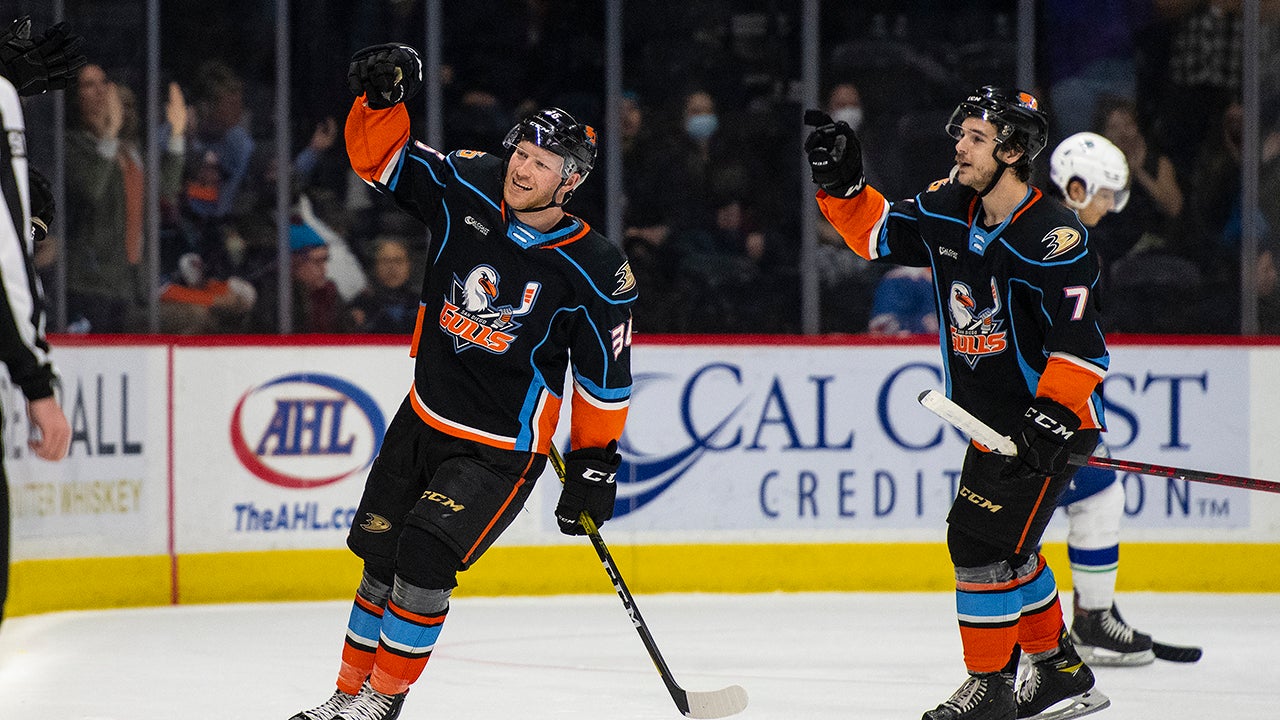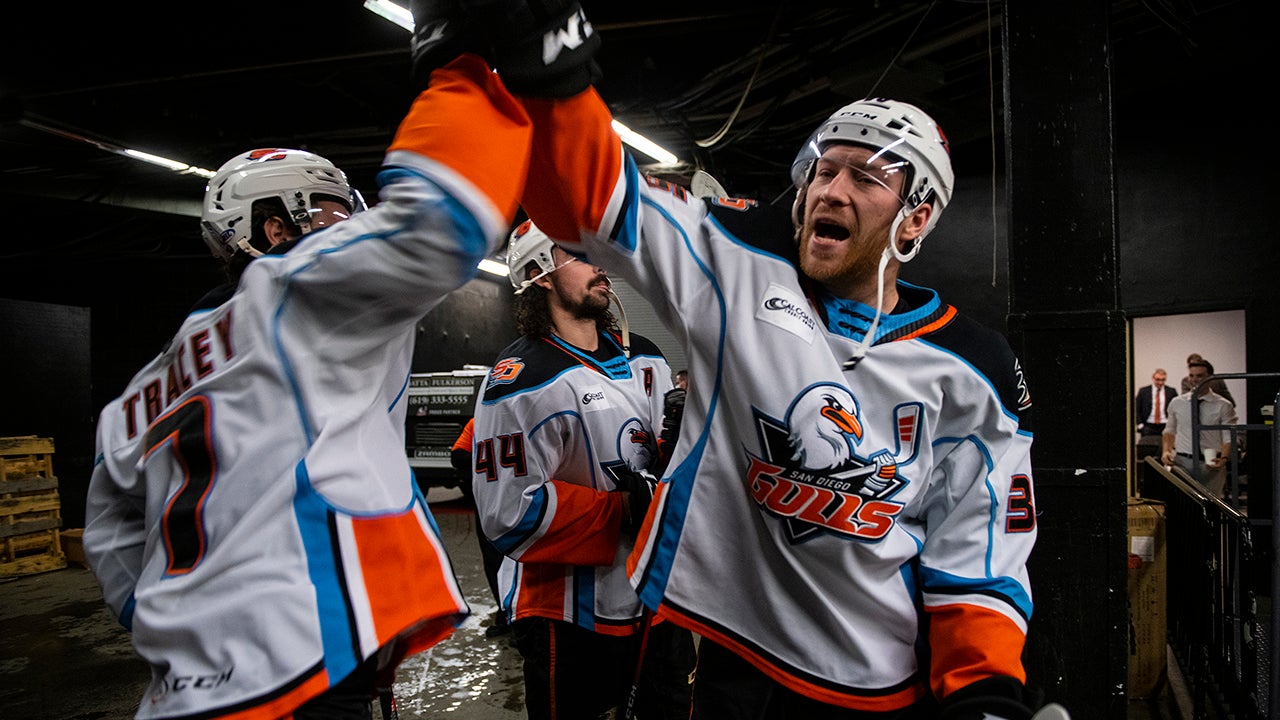Hunter Drew's Move From Defense To Forward Paying Off For San Diego Gulls
Feb 25, 2022
By AJ Manderichio/SanDiegoGulls.com
In early August, as he trained for the upcoming season, Hunter Drew found himself at the crossroads of his young career.
The Kingston, Ontario native entered professional hockey as a defenseman, but spent part of the 2020-21 season with the San Diego Gulls as a forward. What started as a temporary chance to find playing time became a full-time reality when he received a call from Anaheim Ducks Director of Player Personnel Todd Marchant.
“It was kind of like, ‘We have a lot of defensemen; not a lot of room,’ and obviously I played (forward) for half the year last year,” Drew explained following a recent Gulls practice. “They thought that they were seeing something and wanted to go in that direction, so they called me and said, ‘Here’s the deal – we think this can be a good, full-time step for you.’ I agreed to it and went from there.”
Gulls head coach Joel Bouchard also checked in with Drew on the transition.
“You’re right, it’s not easy,” he explained. “We had those discussions this summer. Obviously, the guy has been drafted as a defenseman, but I think at one point, he realized his attributes help him to have a progression into pro hockey as a forward. You can see his attributes – his shot, puck skill, he can see players behind the first line of defense where he can execute. Now it’s just about learning the position. Obviously, for a d-man switching to forward, the play along the wall are going to be the toughest; the breakout, the transition. The way we taught him, I think he’s embraced that, he’s been good at it. It’s allowed him to maybe not be so uncomfortable in situations where he would be.”
The move is paying off for both parties. In his third season – and his first as a full-time forward – Drew entered Friday, Feb. 25 as one of San Diego’s best offensive players. He’s riding a career-high four-game point streak, collecting 4-3=7 points over that span. In addition, he’s recorded multi-point performances in back-to-back games and grabbed the team lead in goals (10). He’s also set new career-highs in several offensive categories.
Drew was also tied for second in the American Hockey League for the most points earned (3-3=6) and tied for first with a +7 rating from Feb. 14- Feb. 20.
“When you produce a little bit, it gives you confidence and you can take that into every aspect of your game,” Drew said. “Confidence means comfort, too, so you feel like you can make this play or you know where to be in the d-zone or you know you have to go out there and fight this guy and help my team. I think confidence like that and the comfort goes a long way.”

The change took some time for the defenseman-turned-forward, who entered training camp with the unique experience of spending his career on the blueline.
“It's a different game,” Gulls assistant coach Max Talbot explained. “As a defenseman, you’re skating backward and you see the whole ice. As a forward, you have to skate and time yourself a little better. For him to have both experience, it’s good. That’s why we get the young hockey players, like my son, to touch every position. He was curious; he asked a lot of questions, so all the credit goes to him.”
The transition clicked around the new year, when the National Hockey League re-instituted Taxi Squads amid a surge in COVID-19 protocols affecting its teams. With several top Gulls recalled to the Anaheim Ducks, it gave players like Drew the chance to earn more ice time.
“A blessing in disguise was the Taxi Squad coming back, for me personally,” he said. “When your best players go up on the Taxi Squad, guys like me who play in the bottom six or who are in and out of the lineup slide into a bigger role. You don’t wish anyone to get sick or hurt ever, but if an opportunity comes up you want to make the most of it. That’s where I tried to get my feet under me, get moving, and I feel like I took advantage of that and hopefully keep doing that the rest of the year.”
Talbot agreed with his assessment.
“It’s been a weird season where, if you add COVID, the Taxi Squad and losing guys, he was able to play anywhere,” he explained. “It was definitely not easy because we needed him on defense at one point too, then he played some shifts on the PK, then he was on the power play. Then everybody comes back and you’re not on the power play anymore, and then you’re on the fourth line and that’s the one that’s been producing lately. It’s not easy.”
The increased ice time coincided with a concerted effort to control his emotions. Drew is a fiery player, never afraid to throw a big hit or drop the gloves with some of the toughest enforcers across the league. As he climbed the lineup, he learned the balance between his emotional style and a calculated approach.
“Learning a new position, sometimes you’re going to make mistakes and struggle,” Drew said. “Sometimes I would let that take control of my game instead of sitting down and saying, ‘This is your first time through.’ I didn’t ease myself into it. I’m pretty hard on myself and have high expectations. I wanted to prove I could do it. A big thing for me was working on my emotion and trying to channel it the right way. Two years of pro before this, and you get halfway through the year and you realize you play so many games, you have so many opportunities. One shift, one game doesn’t define your career, doesn’t define your year.
“Once you sit back and, like you said, I’m getting a bit older now and maturing, realizing hockey is equally as much mental as it is physical. If you only have one or the other, you’re not going to be successful.”
An example of that balance is Talbot, who mixed physical play with a scoring touch across his storied 12-year NHL career.
“That’s the dance, right,” Talbot said. “To me, I call it the game within the game. I liked to do this when I was a player also, but it’s knowing when and how. It’s really an art, and Hunter is a guy that’s very emotional. You need emotions in your game, especially when you play that type of game. Now, he’s our leading goal scorer, but he’s a still a guy that brings energy and physicality. It’s about knowing where and when, and that’s still something that the more you gain experience, the better you get at this.
“You have to learn, you have to do mistakes and sometimes lose your temper to learn, ‘Oh, that was too much.’ That’s what happened with him this year. At the start, sometimes it was ‘Oh,’ and the coach says it’s a little too much, and you find that balance. I feel he was able to do that. That’s progressing.”

With this balance, Drew could further explore his tools. One of those is his shot, which he’s unleashed with incredible success over the last six weeks.
“You look at the type of goals he’s shot, I can easily have six or seven in my head that are from the flank attacking on the 2-on-1, 2-on-2, shooting from the circle,” Talbot said. “That’s what he has in his toolbox, and that shot is dangerous. You have to know when and where to shoot from, and he has that in the bag. It’s a skill, but it takes time. It’s an adjustment, it’s a different spot from the blue line, but he definitely has that flair.”
Drew also found an increased level of comfort with the acquisition of Brent Gates Jr., who signed a standard player contract (SPC) with San Diego on Dec. 31. The two are both draft selections of the Ducks and spent many of their first years in the organization together at the team’s rookie camps, creating a strong friendship on and off the ice.
“I think we work really well together,” Drew explained. “We’re really good buddies off the ice, so when you have someone you can lean on, if I’m struggling he’ll find a way to help me and vice versa. If he’s struggling, I want to find a way to help him. He’s so poised and calm, he sees the ice so well that I’m thinking I don’t have to be wide open or be the one who has to bring the puck up the ice, do a tight turn, beat a guy and slide it back door. I kind of find myself in these areas and he’s really good at finding me. We work really well together. He helps compliment my game a lot.
“We always joke about it. We say me, him and (Gulls forward Alex) Limo(ges) are the best fourth line in hockey. Obviously, it’s not true but it’s funny. We kind of laugh about it. We’re all doing well and it’s fun to see.”
The learning hasn’t stopped for Drew, as he continues to work with the coaches and on his own time to better learn his new position. He cites Cal Clutterbuck, a gritty forward for the New York Islanders, as an NHL player he tries to model his game after. Clutterbuck, like Drew, is known for a physical game with little hesitation to drop the gloves when necessary. Neither is a noted goal scorer – Drew joked he’s “not expected to score 50 goals a year” – but his elevated play is key for a Gulls team looking to start a second-half run.
“Credit to the player,” Bouchard said. “It was challenging at the beginning for him, as everything will be, and I’m quite demanding. I have to say he’s bought in; he’s understanding his role and what he can bring to the table, and he’s improving.”